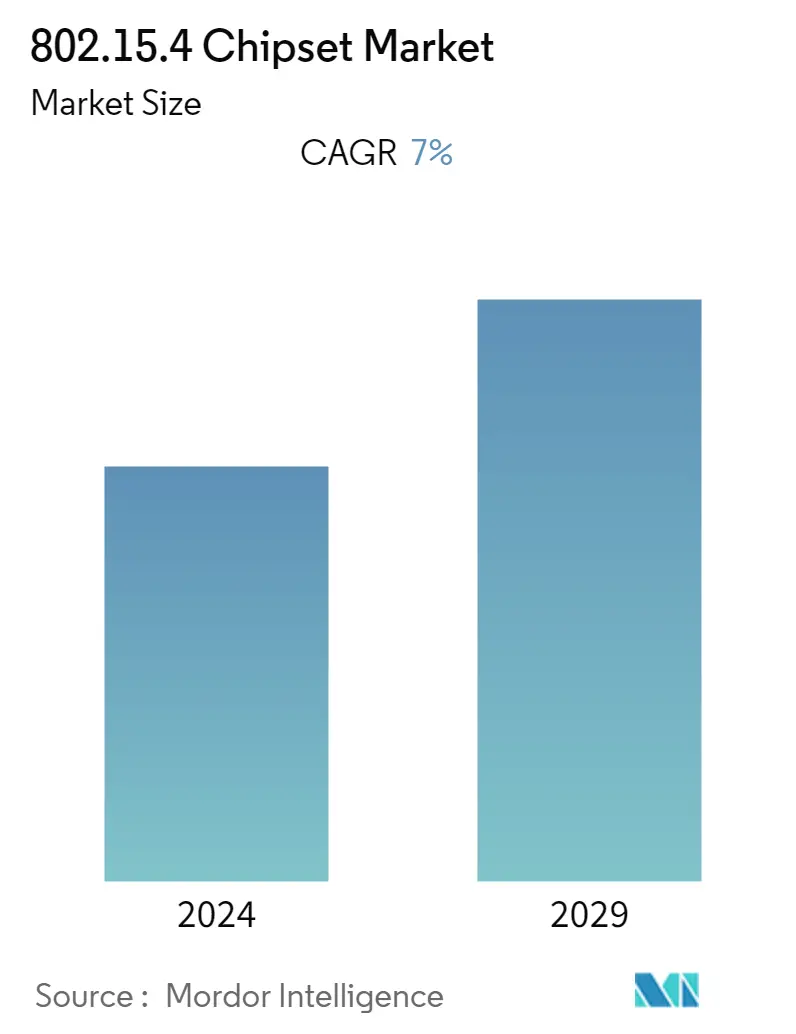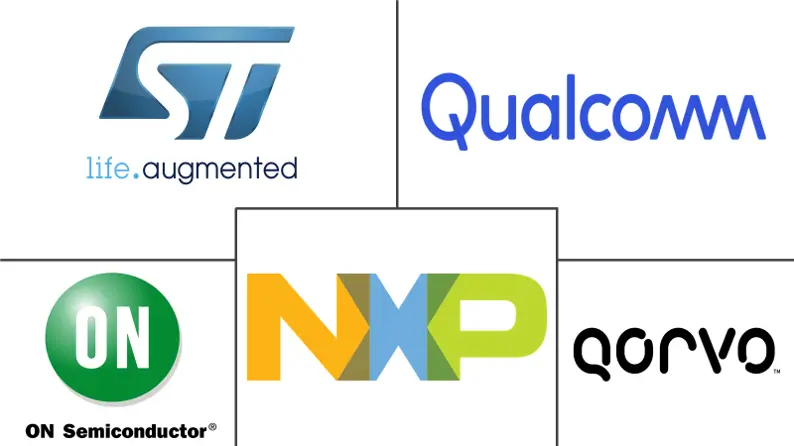Market Size of 802.15.4 Chipset Industry

| Study Period | 2019 - 2029 |
| Base Year For Estimation | 2023 |
| CAGR | 7.00 % |
| Fastest Growing Market | Asia Pacific |
| Largest Market | Asia Pacific |
| Market Concentration | Low |
Major Players
*Disclaimer: Major Players sorted in no particular order |
802.15.4 Chipset Market Analysis
The 802.15.4 chipset market is expected to register a CAGR of 7%, over the forecast period (2021-2026). The IEEE's 802.15.4 standard defines the MAC and physical layer of the network used by networking specifications, such as Zigbee, 6LoWPAN, Thread, WiSUN, and MiWi protocols. It is created to support low cost and low powered personal area networks.
With the increasing acceptance of IoT across different end-user levels, such as home and building and industrial, the stakeholders in the electronics space have been continuously innovating in rolling out the necessary components (chipsets, modules, etc.), to cater to these needs. 802.15.4 chipsets serve the purpose by utilizing a low-data rate, which, in turn, reduces the power consumption considerably.
Using 802.15.4 chipsets, along with ZigBee communication offering better network routing schemes, are designed to ensure power conservation and low latency through guaranteed time slots. Moreover, the reason that they are being deployed for various applications is that even if there is a single point of failure, the communication may not get affected due to the implementation of the mesh network.
An increasing number of used cases, depicting the use of 802.15.4-based chipsets for their smart home and other IoT products, lead to the growth of the market studied. However, due to the outbreak of COVID-19 in the United States, China, and European countries, manufacturing plants may sit idle, which may result in a scarcity of 802.15.4 chipsets for the manufacturers and retailers all over the world.
802.15.4 Chipset Industry Segmentation
802.15.4-based products from vendors, such as Microchip Technology Inc., STMicroelectronics NV, NXP Semiconductors NV, and Qualcomm Inc., are increasingly being used in a wide range of applications, from battery-free, energy-harvesting wireless light switches, to high-performance mesh utility networks that support smart meters and street lighting.
| By Type | |
| Single-protocol/Standalone 802.15.4 Chipsets | |
| Multi-protocol Chipsets |
| By Application | |
| Smart Home | |
| Industrial Automation | |
| Smart Meeting | |
| Smart City (Outdoor Lighting, City Network Connectivity, etc.) | |
| Other Applications |
| By Geography | ||||||
| ||||||
| ||||||
| ||||||
| Latin America | ||||||
| Middle-East and Africa |
802.15.4 Chipset Market Size Summary
The 802.15.4 chipset market is poised for significant growth, driven by the increasing adoption of IoT technologies across various sectors, including smart homes, industrial automation, and smart cities. The IEEE 802.15.4 standard, which underpins protocols like Zigbee, 6LoWPAN, and Thread, is designed for low-cost, low-power personal area networks, making it ideal for applications requiring energy efficiency and cost-effectiveness. The market is characterized by a diverse range of applications, from wireless sensor networks to machine-to-machine communications, with Zigbee emerging as a dominant player due to its advantages in network routing, power conservation, and low latency. The ongoing technological advancements and the growing trend of smart city developments, particularly in the Asia-Pacific region, are expected to further fuel demand for these chipsets.
The market landscape is fragmented, with established players such as STMicroelectronics, NXP Semiconductors, and Qualcomm holding significant market shares. However, the entry of new players and the continuous innovation in 802.15.4-based communication protocols are expanding the competitive dynamics. The demand for these chipsets is particularly strong in developing economies, where initiatives like India's Smart Cities Mission are creating substantial opportunities for growth. Recent product launches, such as NXP's JN5189 and JN5188 wireless microcontrollers and Qualcomm's QCA4020 multi-mode SoC, highlight the industry's focus on enhancing connectivity solutions for IoT applications. As the market evolves, the emphasis on security and interoperability standards, driven by major tech companies joining alliances, is expected to further bolster the adoption of 802.15.4 chipsets globally.
802.15.4 Chipset Market Size - Table of Contents
-
1. MARKET DYNAMICS
-
1.1 Market Overview
-
1.2 Market Drivers
-
1.2.1 Increasing Acceptance of Home Networking, Industrial Control, and Building Automation
-
1.2.2 Introduction of Multi-protocol 802.15.4/Bluetooth/WiFi Chips to Address IoT Fragmentation and Support for Interoperability
-
-
1.3 Market Restraints
-
1.3.1 Alternative Protocols, such as Bluetooth, Wi-Fi, and Z-Wave, Among Others
-
-
1.4 Industry Attractiveness - Porter's Five Forces Analysis
-
1.4.1 Threat of New Entrants
-
1.4.2 Bargaining Power of Buyers/Consumers
-
1.4.3 Bargaining Power of Suppliers
-
1.4.4 Threat of Substitute Products
-
1.4.5 Intensity of Competitive Rivalry
-
-
1.5 Industry Standards and Developments
-
1.5.1 IEEE 802.15.4
-
1.5.2 IEEE 802.15.4e
-
1.5.3 IEEE 802.15.4e Time-slotted Channel Hopping (TSCH)
-
1.5.4 IEEE 802.15.4k (Low Energy Critical Infrastructure Networks)
-
1.5.5 IEEE 802.15.4g (Smart Utility Networks) etc.
-
-
1.6 Assessment of COVID-19 on the Industry
-
-
2. MARKET SEGMENTATION
-
2.1 By Type
-
2.1.1 Single-protocol/Standalone 802.15.4 Chipsets
-
2.1.2 Multi-protocol Chipsets
-
-
2.2 By Application
-
2.2.1 Smart Home
-
2.2.2 Industrial Automation
-
2.2.3 Smart Meeting
-
2.2.4 Smart City (Outdoor Lighting, City Network Connectivity, etc.)
-
2.2.5 Other Applications
-
-
2.3 By Geography
-
2.3.1 North America
-
2.3.1.1 United States
-
2.3.1.2 Canada
-
-
2.3.2 Europe
-
2.3.2.1 Germany
-
2.3.2.2 United Kingdom
-
2.3.2.3 France
-
2.3.2.4 Rest of Europe
-
-
2.3.3 Asia-Pacific
-
2.3.3.1 India
-
2.3.3.2 China
-
2.3.3.3 Japan
-
2.3.3.4 Rest of Asia-Pacific
-
-
2.3.4 Latin America
-
2.3.5 Middle-East and Africa
-
-
802.15.4 Chipset Market Size FAQs
What is the current 802.15.4 Chipset Market size?
The 802.15.4 Chipset Market is projected to register a CAGR of 7% during the forecast period (2024-2029)
Who are the key players in 802.15.4 Chipset Market?
STMicroelectronics NV, NXP Semiconductors NV, Qualcomm Inc., ON Semiconductor Corporation and Qorvo Inc. are the major companies operating in the 802.15.4 Chipset Market.

